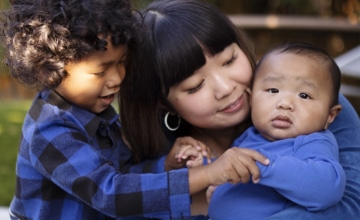Ann T. Chu, University of California, San Francisco
Aimee Hilado, Northeastern Illinois University
Obianuju O. Berry, Columbia University Medical Center, New York State Psychiatric Institute
Abstract
Academic researchers in the infant and early childhood mental health field seek to understand the factors in early childhood that promote lifelong learning, health, and well-being. The inclusion of diverse and underrepresented populations, however, remains a challenge in rigorous research design. This article explores the challenges in addressing inclusive research within academic settings using the experiences of three academic researchers. Recommendations highlight the opportunity to cultivate academic leaders and researchers across diverse settings who give voice to underrepresented young children and families.
The American Psychological Association’s original Guidelines on Multicultural Education, Training, Research, Practice, and Organizational Change for Psychologists (APA, 2002) provided researchers a useful frame for conducting research with diverse populations. The fourth Guideline stated that “culturally sensitive psychological researchers are encouraged to recognize the importance of conducting culture-centered and ethical psychological research among persons from ethnic, linguistic, and racial minority backgrounds.” (APA, 2002, p. 37). In particular, researchers are encouraged to be grounded in the ways that culture influences the scientific process as manifested in research generation and design, assessment, and analysis and interpretation. These guidelines and tenets are especially necessary when the goal is to effectively include the voices of populations that are typically underrepresented in research. Yet, many barriers continue to stand in the way of truly reflecting diversity, equity, and inclusion within academic research. Using three examples from each of the co-authors (who are also three women of color conducting research in institutions of higher education), we seek to shine light on the challenges and opportunities for inclusion and representation in research.
Case Example 1: Examining Intimate Partner Violence Within Minority Populations—Obianuju O. Berry
When I was in training, I evaluated a Latinx mother in the psychiatric emergency room who was 4 months postpartum. She was not sleeping and complained of symptoms of depression, suicidality, and paranoia. She revealed she was a survivor of intimate partner violence (IPV). She clearly needed outpatient mental health care and IPV services, but was befuddled by the system. During my encounter with her as a patient in the medical setting, I recognized the inequalities of the disparate systems she was trying to access that greatly impacted her and undoubtedly her 4-month-old daughter. Thus began my research career into asking the question of the intersectionality of motherhood, mental health, IPV, minority populations, and service provision.
The World Health Organization called IPV a global public health problem of epidemic proportions (2013). Children under 6 years old are at a higher risk than older children for exposure to IPV (Fantuzzo, Boruch, Beriama, Atkins, & Marcus, 1997). Witnessing IPV between caregivers is a particular type of trauma for a child that may have devastating effects on development and can be a threat to infants and young children’s sense of security and well-being (Zeanah et al., 1999). In addition, findings suggest that IPV in the first year postpartum negatively impacts parenting behavior, including warmth and sensitivity (Levendosky, Huth-Bocks, Semel, & Shapiro, 2002).
Yet, despite the known sequelae of IPV, mental health and IPV services have unique socio–political histories and tend to function as distinct systems of service delivery, affecting children who are often caught in the cross hairs. There is a strong need for researchers who can think critically of the science, work in interdisciplinary fields, and use the knowledge to bridge the gap to make translational research (bench to bedside) possible and relevant.
Through strong collaboration and mentorship, I have had the privilege of investing my time with Columbia’s Domestic Violence Initiative (DVI). Situated in the South Bronx, New York, a richly diverse community but the poorest congressional district in the United States, with 1 in 3 residents below the federal poverty level, DVI along with Chapman Perelman Foundation, and New York City’s Mayor’s Office to End Domestic and Gender Based Violence, created a unique opportunity to provide free, evidence-based, cultural sensitive psychiatric services (psychopharmacology and psychotherapy) to the Bronx Family Justice Center, a resource center for survivors of IPV and sex trafficking. A literature review suggested that there are few models of psychiatric service provision directly aimed at this population (Berry, Mayumi Weiss, Fitelson, & Monk, 2015), thus creating the first collaboration partnership like this in the United States. This collaborative relationship has also made it possible to conduct novel research in this underserved population and serves as the groundwork for my research interests.
This team’s research is guided by intersectional theory. By addressing the needs of mothers in the South Bronx community who have been affected by IPV and mental health, it is necessary to recognize the multiple forms of diversity and social forces that simultaneously impact this community. An intersectional approach emphasizes the importance of exploring both similarities and differences in patterns of violence against women and the way this is experienced by individuals according to their social and cultural context (Pease & Rees, 2008). Furthermore, the research is aimed at the convergence of IPV and mental health disorders as it impacts parenting and young children, who are often marginalized and have not been able to access IPV or mental health services in the past. Building on literature that remission of maternal depression improves psychological outcomes of the children, the goal of the study is to demonstrate the effectiveness of a program targeting maternal treatment of mental health sequelae of IPV and how maternal improvement affects children through possible moderation of parental capacity change.
Despite strong pushes for awareness, both IPV and mental health disorders are still largely hidden. Too often, the voices of those affected are silenced. Because of its sensitivity, research on IPV disempowers survivors; even more so when young children or minorities are involved. First, as research subjects, there is an inherent hierarchical structure between participants and researchers who determine who should be in the study, how the study is run, how questions are asked, and even payment of services. Second, survivors are seen as a stigmatized and marginalized community whose stories and tragedies are gleaned for certain information, but not necessarily inclusive of the struggles that they face with sharing their stories. Third, the needs of women of color, refugee and immigrant women, or non-English speaking survivors of IPV or mental health conditions are too often not addressed in research or interventions that have not deliberately sought to be inclusive in their approach (Lee, Thompson, & Mechanic, 2002). Fourth, caregivers or people in authority speak for young children, often denying their voices and unique stories. These four deficits also reflect the larger intervention research field where there are inadequate representations of ethnic/racial minority groups in studies of evidence-based treatments (Bernal & Scharró-del-Río, 2001). By not being inclusive in the methodological rigor of IPV research, researchers are not privy to certain voices that provide nuanced metrics to the global needs of survivors and families with young children.
As a clinician, researcher, and advocate, I need to bear witness to these nuances and capture them within the data to move the field forward. These questions would not have surfaced for me had I not been open to the possibility that research affords us the opportunity to explore. As a person of color, it is paramount, too, that researchers are not silenced as the questions they ask in research can be rich and complex.
Case Example 2: Understanding the Impact of Home Visiting Among Refugee and Immigrant Families—Aimee Hilado
I am both an academic researcher affiliated with a teaching institution and a clinician affiliated with a community-based mental health program that provides infant and childhood early mental health (IECMH) services for refugee and immigrant families. My dual lens of integrating direct practice and scholarship has been critical to effectively studying diverse and vulnerable communities.
In 2011, I started the RefugeeOne Wellness Program to promote the health and mental well-being of forcibly displaced refugees and immigrants who were being served at a refugee resettlement program in Illinois. During therapy sessions, parents often spoke about concerns for their children. In response, the Wellness Program began offering clinical services to children and youth 5–18 years old in schools, in the agency’s after-school program, and in the home.

Over time, parents began to share more concerns; they spoke of infants and toddlers who were difficult to soothe, who were easily startled, and of the stresses of trying to support them. Photo: kryzhov/shutterstock
Over time, parents began to share more concerns; they spoke of infants and toddlers who were difficult to soothe, who were easily startled, and of the stresses of trying to support them. Preschool and kindergarten teachers also expressed concerns about challenging behaviors suggesting attention deficit hyperactivity disorder or learning disabilities. It became clear to program staff that we needed to extend mental health services to the infants and young children in these families. There is an entire generation of displaced children growing up in families that have experienced immigration trauma in their journeys to the United States; that trauma has, in some cases, impaired the parent–child relationship.
In 2015, the program implemented home visiting using the Baby TALK Model to serve pregnant mothers and children from birth to 3 years old, using funding from the Illinois State Board of Education to offer services not in the typical early education setting but a mental health program in a refugee resettlement agency. Given the novelty of the program context and the population being served—refugees and immigrants—the Board also provided research dollars to understand the impact of these services. A randomized controlled trial involving 200 participants of refugee and immigrant status was completed. The findings suggested that young children in this sample show statistically significant improvements in the area of social–emotional and language development as a result of Baby TALK home visiting services (Hilado, Leow, & Yang, 2019). Parents receiving home visiting also showed less stress and trauma symptoms as a result of the intervention. Follow-up interviews suggested that the parent–home visitor relationship led to developmental and mental health gains. While home visiting is not therapy, it was experienced as therapeutic. These findings are critical in understanding the impact of interventions on communities underrepresented in research.
Although the study design and data analyses followed traditional research protocols, the time I took to involve community leaders and families and to build relational aspects into the assessment process made this study unique. The study engaged participants who had been in the country for no more than 7 years and came with a history of trauma; they had never been involved in home visiting services in the past or research studies; and they had immigration statuses that made them feel particularly vulnerable in the current sociopolitical climate.
My lens as a clinician and an immigrant allowed me to place the context of participants at the center of the research design. I conducted an in-depth informed consent process to make sure that families understood the voluntary nature of the study and the benefits. I engaged community leaders and known field interpreters to address concerns about trusting outsiders with private family information. I provided incentives that would be most helpful to the families, including diapers and wipes. Most important, other staff members and I spent time with each family during the assessment process to be sure we had a connection with participants. Relationships are critical within the cultures we were engaging, and something I personally value as a Filipina-American second-generation immigrant. Relationship-building included drinking tea together and talking about the family’s adjustment and hopes for the future. The research questions and design were secondary to making sure there was a strong connection, knowing that the success of the study, as well as the home visiting intervention, would never be realized if we could not develop a trusting research partnership with participants.
This research project highlights the importance of understanding the context of the study sample and its participants in an effort to design and execute research that involves underrepresented voices. Staff members and I conducted assessment procedures with attention to participants’ cultural contexts in order to maximize responses, as classic studies have demonstrated cultural differences to responses on quantitative questionnaires (Bachman & O’Malley, 1984). The predominant reliance on research methods and measures normed with White/mainstream populations in social science research has driven an oversimplified, de-contextualized approach to many research studies (Burlew, Peteet, McCuistian, & Miller-Roenigk, 2019). The result was a successful study and an engaged immigrant sample who could be represented in mainstream research on the effectiveness of home visiting.
Case Example 3: The Study of Non-White Non-College Samples—Ann T. Chu
I was fortunate to have been mentored in my psychology graduate training by a trauma researcher who greatly valued community-based research. All the major studies in our research lab collected data from non-college aged and predominantly non-White participants. My master’s project looked at the development of dissociation in school-aged children within the context of particular parenting practices and as influenced by maternal betrayal trauma histories. I recruited participants by posting on online forums, at street corners, cafe bulletins, and library community boards. More than 70 mother–child dyads later, I was able to show that both mothers’ and children’s betrayal trauma histories significantly predicted children’s dissociation (Chu & DePrince, 2006). This experience was followed by helping with another major research project where we developed a measure on post-trauma appraisals—the Trauma Appraisal Questionnaire (DePrince, Zurbriggen, Chu, & Smart, 2010) by recruiting multiple community participants—again primarily from online forums, community agencies, and homeless shelters.
These experiences set the stage for my dissertation project where I explored the link between risk detection and revictimization in a community sample of sexual assault survivors. I based my project on previous research findings that the ability to detect danger cues in dangerous situations was linked to number of victimizations experienced in multiple women, where no- and singly-victimized college women were faster to press a button to indicate danger during a vignette as compared to multiply-victimized college women (Marx, Heidt, & Gold, 2005). After more than 1 year of recruitment, data collection, data cleaning, and analysis, I did not replicate this finding, which has been demonstrated in multiple college samples. I ended up still getting the null results published (Chu, DePrince, & Mauss, 2014), precisely because I did not replicate in a community sample the original findings in various college samples. I discussed how college samples are typically composed of predominantly Caucasian, educated, young women with financial resources to attend secondary education; and I pointed out the obvious need to study the generalization of findings on risk detection to more racially, educationally, and socioeconomically diverse community samples.

Many barriers continue to stand in the way of truly reflecting diversity, equity, and inclusion within academic research. Photo: Rawpixel.com/shutterstock
This question of generalizability is not a new one. Scholars have pointed out the fact that social sciences have been built upon “White rats and White college students” (Cauce, 2011, p. 230). In an analysis of a premier APA journal, 67% of published articles consisted of undergraduate psychology student samples (Arnett, 2008). Even when community samples are used, convenience sampling triumphs. Most major research institutions are located in urban or suburban regions, resulting in the phenomenon of rural samples being largely ignored. A systematic review of the 14 most frequently cited social work journals found studies that included rural samples in 2.4% of the studies (Slovak, Sparks, & Hall, 2011). In two reviews on studies examining evidencebased practices or behavioral health interventions in rural settings, both reviews identified only eight studies that used a rural population as all or part of the sample (Lee, 2017; Trawver, Brocious, & Aguiniga, 2019). Similarly, “hidden” populations such as recent or undocumented immigrants, Pacific Islanders, and Native Americans are rarely included in research despite vast disparities in health and economic outcomes when data are disaggregated into those specific groups (Charmaraman, Woo, Quach, & Erkut, 2014; Katigbak, Foley, Robert, & Hutchinson, 2016). For research analysis and interpretation to be culturally sensitive, researchers first have to have the data included in their samples. Such inclusion is also necessary because the findings are often used to support subsequent research, inform practices, and, most important, inform policies that shape the daily experiences of entire communities.
The early research experiences in graduate school laid the path for me to continue to engage in community-based clinical research. Currently, I am part of a clinical research team examining the treatment effectiveness of a dyadic treatment model for young children and their caregivers who have been exposed to trauma. All five of the randomized controlled trials for this treatment model have included diverse samples with a variety of trauma experiences (Cicchetti, Rogosch, & Toth, 2006; Cicchetti, Toth, & Rogosch, 1999; Lieberman, Van Horn, & Ghosh Ippen, 2005; Lieberman, Weston, & Pawl, 1991; Toth, Maughan, Manly, Spagnola, & Cicchetti, 2002). For our current research studies, my team and I continue to use methodology that can be inclusive of interested participants, such as online recruitment and video conference to access participants who are not in our immediate urban setting, and conducting interviews in multiple languages. As the field continues to diversify with academic researchers from varied backgrounds, researchers can continue to learn from each other to embrace methodologically sound high-quality research strategies that are culturally competent (Burlew et al., 2019).
Recommendations for the Field
Gordon Hall’s seminal text, Multicultural Psychology, stated that “Whereas the assumption in traditional psychology is that theories and research are generalizable, the assumption in multicultural psychology is that there are both universal and culture-specific phenomena, with an emphasis on the latter” (Hall, 2010, p. 2). This definition of multiculturalism means doing away with the quest for universality and embracing the assumption that truly understanding human behavior is to balance the desire for parsimony with the necessity of complexity. In addition, to better understand and appropriately intervene in a multicultural world requires researchers to draw on a more inclusive (and diverse) set of research methodologies (for best practices recommendations, see Burlew et al., 2019).
The case examples highlighted here are from the academic experiences of three academic researchers across disciplines who are all women of color. It is likely not coincidental that we are all engaged in clinical research with diverse communities while understanding the need for accommodations in research design to include underprivileged groups and asking questions that are influenced by our cultural experiences. We are also not the norm. Of all full-time faculty in degree-granting postsecondary institutions in the fall of 2017, 41% were White males; 35% were White females. For faculty of color, 6% were Asian/Pacific Islander males; 5% were Asian/Pacific Islander females; and Black males, Black females, Hispanic males, and Hispanic females were each 3% of the total (U.S. Department of Education, National Center for Education Statistics, 2019). Faculty of color also face multiple barriers to career advancement, including higher financial burdens, social and professional isolation, and race- or ethnic-related biases (Alegría, Fukuda, Lapatin Markle, & NeMoyer, 2019).
Despite these statistics and barriers, we Fellows have all been successful in our academic careers and arrived at the IECMH field with the support of personal and professional mentors. Mentors with similar cultural experiences or worldviews, advisors who have modeled different career paths or diverse research methods, and organizational leaders who supported research endeavors that take longer due to collaborative community- or partnership-building have all contributed to our success. At the same time, we are aware that there are few mentorship or training programs specifically for faculty from underrepresented minority groups (Beech et al., 2013).

Methodology that can be inclusive of interested participants includes online recruitment and video conference, to access participants who are not in our immediate urban setting, and conducting interviews in multiple languages. Photo: Rawpixel.com/shutterstock
Consequently, leadership development programs such as the ZERO TO THREE Fellowship are critical. It is a Fellowship that values diverse representation and promotes discussions around how to consider issues of diversity, equity, and inclusion in the IECMH field; issues so important and conversations that are necessary to advance the field for all families. It allows for underrepresented faculty to create a peer support network for each other, seek career navigation advice, and create research and professional collaborations with partners from diverse backgrounds. The ZERO TO THREE Fellowship also allows us to “pay it forward” as we can model for others the same mentoring practices that were modeled for us. We are now faculty mentors and advocates for students and trainees newly entering the field as researchers and clinicians who will similarly strive for equity, inclusion, and valuing diversity in their own work. Our efforts represent an important endeavor in a field that continues to be limited in diversity in both graduate training programs and the workforce. To illustrate, African Americans and Hispanics/Latinos together accounted for only 14% of doctoral recipients; American Indian/Alaska Native constituted less than 1% in 2018 (National Science Foundation, 2018). Among active psychologists, 83.6% are White, 5.3% are Black, 5.0% are Hispanic/Latino, 4.3% are Asian, and 1.7% are other racial/ethnic groups (APA, 2015). Such statistics only illuminate further challenges of reflecting diversity within academic fields; qualities that could potentially influence the nature of engagement and research design with underrepresented participant voices.
This discussion is not provided as a way of stating that multicultural and culturally sensitive research must come from academic researchers who are racially, ethnically, or culturally diverse. This discussion does highlight the inherent value in cultivating diverse academic researchers and the importance of intervening in a multicultural world with research that embodies the voice of many rather than a few. To address this tension, there have been calls to correct this trend by developing systems-level reforms in graduate programs that address varying domains from admissions, cultural competence training for both students and faculty, departmental climate, mentoring programs, and research activities with diverse populations (Callahan et al., 2018). These ongoing activities will continue to cultivate future generations of researchers who reflect inclusiveness and equity within academic institutions as well as the research that is produced.
This dual focus and call to action—the need for more inclusive IECMH research and more representation of diversity in academic research—has implications for best practices in the field, program/community-level funding opportunities, and larger IECMH policy efforts that impact diverse communities broadly. The ZERO TO THREE Fellowship embodies this dual focus and call to action. As a result, we are further inspired to engage others and ourselves in more IECMH research that reflects the needs of infants and toddlers across the diverse communities we have the privilege of serving.
Author Bios
Ann T. Chu, PhD, is currently an assistant clinical professor at the University of California, San Francisco (UCSF) and associate director of dissemination for Child–Parent Psychotherapy (CPP) at the UCSF Child Trauma Research Program. As associate director of dissemination, Dr. Chu works with the CPP Dissemination and Implementation Team to train community providers in CPP, standardize CPP training model components, and develop dissemination tools that can further the implementation of CPP. She is interested in bringing trauma-informed principles and CPP-based interventions (e.g., Attachment Vitamins) to child-serving systems such as primary care, child care/early childhood education, and child welfare. Dr. Chu is currently working with research partners to evaluate the effectiveness of Attachment Vitamins and whether CPP works for children with exposure to specific types of trauma such as sexual abuse and traumatic bereavement.
Aimee Hilado, PhD, LCSW, is a licensed clinical social worker and academic researcher specializing in immigration trauma and immigrant/refugee mental health. Dr. Hilado is an associate professor of social work at Northeastern Illinois University where she teaches and conducts research on the importance of early development, early childhood and adult mental health, social support, and culturally sensitive clinical practice with immigrants and refugees. She is also the founding clinical director of the RefugeeOne Wellness Program, a mental health program established in 2011 for immigrants and refugees at the largest refugee resettlement agency in Chicago. In addition, Dr. Hilado continues to present nationally and publish in the areas of mental health, home visiting, and culturally sensitive clinical practice; her most recent edited book is Models for Practice With Immigrants and Refugees: Collaboration, Cultural Awareness, and Integrative Theory.
Obianuju “Uju” O. Berry, MD, MPH, is a graduate of Harvard Medical School, the Johns Hopkins Bloomberg School of Public Health, the NewYork-Presbyterian/Columbia/NYSPI Psychiatry Residency Training Program, and the NewYork-Presbyterian Child and Adolescent Psychiatry Residency Training Program. She has expertise in child/adolescent and adult psychiatry, as well as reproductive psychiatry. Dr. Berry is experienced in mental health research and public policy, and she has worked with a variety of state and federal institutions, including the Centers for Disease Control and Prevention, the U.S. Department of Health and Human Services, and the National Institute of Domestic Violence in the African American Community. She currently is leading a city-wide hybrid implementation effectiveness study on the evaluation of the collaboration between psychiatry and intimate partner violence with New York City’s Mayor’s Office to End Domestic and Gender Based Violence. Dr. Berry’s research and clinical interests include child/adolescent mental health, epidemiology, trauma, service implementation, and working with minority and immigrant populations.
Suggested Citation
Chu, A. T., Hilado, A., & Berry, O. B. (2020). Elevating the voice of underrepresented young children and their families: Reflecting diversity, equity, and inclusion within academic research. ZERO TO THREE Journal, 40(5), 42–49.
References
Alegría, M., Fukuda, M., Lapatin Markle, S., & NeMoyer, A. (2019). Mentoring future researchers: Advice and considerations. American Journal of Orthopsychiatry, 89(3), 329–336.
American Psychological Association. (2002). Guidelines on multicultural education, training, research, practice, and organizational change for psychologists. Washington, DC: Author.
American Psychological Association. (2015). Demographics of the U.S. psychology workforce: Findings from the American Community Survey. Washington, DC: Author.
Arnett, J. J. (2008). The neglected 95%: Why American psychology needs to become less American. American Psychologist, 63, 602–614.
Bachman, J. G., & O’Malley, P. M. (1984). Yea-saying, nay-saying, and going to extremes: Black–White differences in response styles. Public Opinion Quarterly, 48, 491–509.
Beech, B. M., Calles-Escandon, J., Hairston, K. G., Langdon, S. E., Latham-Sadler, B. A., & Bell, R. A. (2013). Mentoring programs for underrepresented minority faculty in academic medical centers: A systematic review of the literature. Academic Medicine, 88, 541–549.
Bernal, G., & Scharró-del-Río, M. R. (2001). Are empirically supported treatments valid for ethnic minorities? Toward an alternative approach for treatment research. Cultural Diversity & Ethnic Minority Psychology, 7(4), 328–342.
Berry, O. O. B., Mayumi Weiss, M., Fitelson, E., & Monk, C. (2015). Collaborations between domestic violence psychiatric services: A review of the literature. Paper presented at the American Psychiatric Association: Institute on Psychiatric Services, New York, NY.
Burlew, A. K., Peteet, B. J., McCuistian, C., & Miller-Roenigk, B. (2019). Best practices for researching diverse groups. American Journal of Orthopsychiatry, 89(3), 354–368.
Callahan, J. L., Smotherman, J. M., Dziurzynski, K. E., Love, P. K., Kilmer, E. D., Niemann, Y. F., & Ruggero, C. J. (2018). Diversity in the professional psychology training-to-workforce pipeline: Results from doctoral psychology student population data. Training and Education in Professional Psychology, 12, 273–285.
Cauce, A. M., (2011). Is multicultural psychology a-scientific? Diverse methods for diversity research. Cultural Diversity & Ethnic Minority Psychology, 17, 228–233.
Charmaraman, L., Woo, M., Quach, A., & Erkut, S. (2014). How have researchers studied multiracial populations? A content and methodological review of 20 years of research. Cultural Diversity and Ethnic Minority Psychology, 20, 336–352.
Chu, A., & DePrince, A. P. (2006). Development of dissociation: Examining the relationship between parenting, maternal trauma and child dissociation. Journal of Trauma and Dissociation, 7, 75–89.
Chu, A. T., DePrince, A. P., & Mauss, I. B. (2014). Exploring revictimization risk in a community sample of sexual assault survivors. Journal of Trauma & Dissociation, 15, 319–331.
Cicchetti, D., Rogosch, F. A., & Toth, S. L. (2006). Fostering secure attachment in infant in maltreating families through preventive interventions. Development and Psychopathology, 18, 623–650.
Cicchetti D., Toth S. L., & Rogosch F. A. (1999). The efficacy of toddler-parent psychotherapy to increase attachment security in offspring of depressed mothers. Attachment and Human Development 1, 34–66.
DePrince, A. P., Zurbriggen, E. L., Chu, A. T., & Smart, L. (2010). Development of the Trauma Appraisal Questionnaire. Journal of Aggression, Maltreatment, & Trauma, 19, 275–299.
Fantuzzo, J., Boruch, R., Beriama, A., Atkins, M., & Marcus, S. (1997). Domestic violence and children: Prevalence and risk in five major U.S. cities. Journal of American Academy of Child & Adolescent Psychiatry, 36, 116–122.
Hall, G. C. N. (2010). Multicultural psychology (2nd ed). Upper Saddle River, NJ: Prentice Hall.
Hilado, A., Leow, C., & Yang, Y. (2019). Understanding immigration trauma and the potential of home visiting among immigrant and refugee families. ZERO TO THREE Journal, 39(6), 44–53.
Katigbak, C., Foley, M., Robert, L., & Hutchinson, M. K. (2016). Experiences and lessons learned in using community-based participatory research to recruit Asian American immigrant research participants. Journal of Nursing Scholarship, 48(2), 210–218.
Lee, M. (2017). Social workers’ evidence-based practice use and challenges in rural environments: A systematic review. Contemporary Rural Social Work Journal, 9, 1–13.
Lee, R. K., Thompson, V. L., & Mechanic, M. B. (2002). Intimate partner violence and women of color: A call for innovations. American Journal of Public Health, 92, 530–534.
Levendosky, A. A., Huth-Bocks, A. C., Semel, M. A., & Shapiro, D. L. (2002). Trauma symptoms in preschool-age children exposed to domestic violence. Journal of Interpersonal Violence, 17, 150–164.
Lieberman, A. F., Van Horn, P. J., & Ghosh Ippen, C. (2005). Toward evidence-based treatment: Child-Parent Psychotherapy with preschoolers exposed to marital violence. Journal of the American Academy of Child and Adolescent Psychiatry, 44, 1241–1248.
Lieberman, A. F., Weston, D. R., & Pawl, J. H. (1991). Preventive intervention and outcome with anxiously attached dyads. Child Development, 62, 199–209.
Marx, B. P., Heidt, J. M., & Gold, S. D. (2005). Perceived uncontrollability and unpredictability, self-regulation, and sexual revictimization. Review of General Psychology, 9, 67–90.
National Science Foundation. (2018). 2016 doctorate recipients from U.S. universities. Retrieved from source
Pease, B., & Rees, S. (2008). Theorising men’s violence towards women in refugee families: Towards in intersectional feminist framework. Just Policy: A Journal of Australian Social Policy, 47, 39–45.
Slovak, K., Sparks, A., & Hall, S. (2011) Attention to rural populations in social work’s scholarly journals. Journal of Social Service Research, 37, 428–438.
Toth S. L., Maughan A., Manly J. T., Spagnola M., & Cicchetti D. (2002). The relative efficacy of two interventions in altering maltreated preschool children’s representational models: Implications for attachment theory. Developmental Psychopathology, 14, 877–908.
Trawver, K. R., Brocious, H., & Aguiniga, D. M. (2019). Inclusion of rural populations in a sample of current mental health intervention research. Journal of Rural Mental Health. Advance online publication.
U.S. Department of Education, National Center for Education Statistics. (2019). The condition of education 2019 (NCES 2019-144), Characteristics of postsecondary faculty. Retrieved from source
World Health Organization. (2013). Responding to intimate partner violence and sexual violence against women: WHO clinical and policy guidelines. Geneva: WHO. Retrieved from source
Zeanah, C. H., B. Danis, L. Hirshberg, D. Benoit, D. Miller, & S. S. Heller. (1999). Disorganized attachment associated with partner violence: A research note. Infant Mental Health Journal, 20, 77–86.





